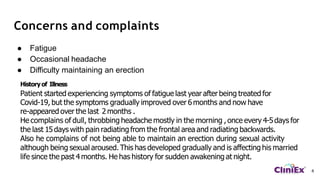This patient is a 55-year-old male with uncontrolled hypertension, uncontrolled type 2 diabetes, stage 1 chronic kidney disease, and dyslipidemia who presents with fatigue, headaches, and erectile dysfunction. His medical history and lab results indicate high cardiovascular risk. The treatment plan involves lifestyle modifications, optimizing medications to better control his blood pressure and blood glucose, and monitoring by a multidisciplinary team to reduce complications.











































